AK-74
The AK-74 (Russian: Автомат Калашникова образца 1974 года or "Kalashnikov automatic rifle model 1974") is an assault rifle developed in the early 1970s by Soviet weapons designer Mikhail Kalashnikov to replace the earlier AKM (itself a refined version of the AK-47). It uses a smaller 5.45×39mm cartridge, replacing the 7.62×39mm chambering of earlier Kalashnikov-pattern weapons.
| AK-74 | |
|---|---|
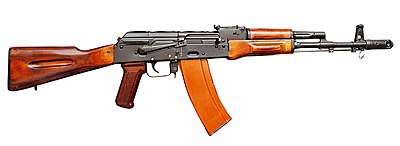 Early AK-74 with "bakelite" magazine and laminated wood furniture | |
| Type |
|
| Place of origin |
|
| Service history | |
| In service | 1974–present[1] |
| Used by | See Users |
| Wars |
|
| Production history | |
| Designer | Mikhail Kalashnikov |
| Designed |
|
| Manufacturer | Kalashnikov Concern (formerly Izhmash) |
| Produced |
|
| No. built | 5,000,000+[4] |
| Variants | See Variants |
| Specifications | |
| Mass |
|
| Length |
|
| Barrel length |
|
| Width | AK-74M: 70 mm (2.8 in) |
| Height | AK-74M: 195 mm (7.7 in) |
| Cartridge | 5.45×39mm |
| Action | Gas-operated, rotating bolt |
| Rate of fire | |
| Muzzle velocity | |
| Effective firing range | |
| Maximum firing range | 3,150 m (3,440 yd) |
| Feed system | 30-round or 45-round RPK-74 detachable box magazine or 60-round casket magazine |
| Sights | Adjustable iron sights, front post and rear notch on a scaled tangent |
The rifle first saw service with Soviet forces in the 1979 Afghanistan conflict.[9] The head of the Afghan bureau of the Pakistani Inter-Services Intelligence claimed that the CIA paid $5,000 for the first AK-74 captured by the Mujahideen during the Soviet–Afghan War.[10]
Today, the rifle is used by most countries of the former Soviet Union. Licensed copies were produced in Bulgaria (AK-74, AKS-74 and AKS-74U), and the former East Germany (MPi-AK-74N, MPi-AKS-74N, MPi-AKS-74NK).[9][11][12]
Design details
The AK-74 was designed by А. D. Kryakushin's group under the design supervision of Mikhail Kalashnikov and is an adaptation of the 7.62×39mm AKM assault rifle and features several important design improvements.[9][13] These improvements were primarily the result of converting the rifle to the intermediate-caliber high velocity 5.45×39mm cartridge. In fact, some early models are reported to have been converted AKMs, re-barreled to 5.45×39mm.[14] Compared with the preceding AKM, the AK-74 has better effective range, firing accuracy (a main development goal), and reliability. The AK-74 and AKM share an approximate 50% parts commonality (interchangeable most often are pins, springs and screws).[9][15][16]
Operating mechanism
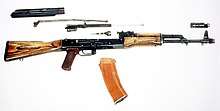
The rifle's operation during firing and reloading is identical to that of the AKM.[17] After ignition of the cartridge primer and propellant, rapidly expanding propellant gases are diverted into the gas cylinder above the barrel through a vent near the muzzle. The build-up of gases inside the gas cylinder drives the long-stroke piston and bolt carrier rearward and a cam guide machined into the underside of the bolt carrier along with an ejector spur on the bolt carrier rail guide, rotates the bolt approximately 35° and unlocks it from the barrel extension via a camming pin on the bolt. The moving assembly has about 5.5 mm (0.2 in) of free travel which creates a delay between the initial recoil impulse of the piston and the bolt unlocking sequence, allowing gas pressures to drop to a safe level before the seal between the chamber and the bolt is broken. Like previous Kalashnikov-pattern rifles, the AK-74 does not have a gas valve; excess gases are ventilated through a series of radial ports in the gas cylinder. Since the Kalashnikov operating system offers no primary extraction upon bolt rotation, the 5.45×39mm AK-74 bolt has a larger extractor claw than the 7.62×39mm AKM for increased extraction reliability.[18] Other minor modifications were made to the bolt and carrier assembly.
Barrel
_(494-28).jpg)
The rifle received a new barrel with a chrome-lined bore and 4 right-hand grooves at a 200 mm (1:7.87 in) or 37 calibers rifling twist rate. The front sight base and gas block were redesigned. The gas block contains a gas channel that is installed at a 90° angle in relation to the bore axis to reduce bullet shear at the port hole. A pair of support brackets are cast into the gas block assembly and are used to attach a BG-15c or GP-25 underslung 40 mm grenade launcher. Like the AK-47 and AKM, the muzzle is threaded for the installation of various muzzle devices such as the standard muzzle brake or a blank-firing adaptor, while a spring-loaded detent pin held in the front sight post prevents them from unscrewing while firing. However the muzzle threads have been relocated to the front sight base for both easier and more economic replacement in case of thread damage. The distinctive standard-issue muzzle brake features a large expansion chamber, two symmetrical vertical cuts at the forward end of the brake and three non symmetrical positioned vent holes to counteract muzzle rise and climb as well as lateral shift to the right much like the AKM's offset muzzle brake. A flat plate near the end of the brake produces a forward thrust when emerging exhaust gases strike its surface, greatly reducing recoil. The muzzle brake prevents backblast from reaching the firer, although it is reported to be harsh on bystanders as the muzzle gases are dispersed to the sides.[19] The standard-issue AK-74 muzzle brake has been subtly revised several times since the 1970s,[20]
Sights
Iron sights
The AK-74 uses an adjustable notched rear tangent iron sight calibrated in 100 m (109 yd) increments from 100 to 1,000 m (109 to 1,094 yd). The front sight is a post adjustable for elevation in the field. Horizontal adjustment requires a special drift tool and is done by the armory before issue or if the need arises by an armorer after issue. The sight line elements are approximately 48.5 mm (1.9 in) over the bore axis. The "point-blank range" battle zero setting "П" standing for постоянная (constant) the 5.45×39mm AK-74 rear tangent sight element corresponds to a 400 m (437 yd) zero, compared with the 300 m (328 yd) zero for 7.62×39mm AKs.[21][22] For the AK-74 combined with the 7N6 or 7N10 service cartridges the 400 m battle zero setting point-blank range limits the apparent "bullet rise" within approximately −5 to +38 cm (−2.0 to 15.0 in) under the line of sight. At the corresponding 440 m (481 yd) maximum point-blank range the bullet will have dropped to approximately −21 cm (−8.3 in) relative to the line of sight. Soldiers are instructed to fire at any target within this range by simply placing the sights on the center of mass (the belt buckle, according to Russian and former Soviet doctrine) of the enemy target. Any errors in range estimation are tactically irrelevant, as a well-aimed shot will hit the torso of the enemy soldier.[21]
Optical sights
.jpg)
While most Russian and CIS armed forces use the AK-74 in its basic configuration with iron sights, many magnified and non-magnified optical sights are available for designated marksmen and other special purpose troops in their respective militaries.[23][24]
For the 5.45×39mm AK-74, the East German Zeiss ZFK 4×25, 1P29, Belorussian BelOMO PO 3.5×21P, PO 4×24P and the 1P78 Kashtan dedicated side rail mounted optical sights were developed. These optical sights are primarily designed for rapid target acquisition and first round hits out to 400 m, but by various means these optical sights also offer bullet drop compensation (BDC) (sometimes referred to as ballistic elevation) for aiming at more distant targets. The BDC feature compensates for the effect of gravity on the bullet at given distances (referred to as "bullet drop") in flat fire scenarios. The feature must be tuned for the particular ballistic trajectory of a particular combination of gun and cartridge at a predefined muzzle velocity and air density. Since the usage of standardized ammunition is an important prerequisite to match the BDC feature to the external ballistic behaviour of the employed projectiles, these military optical sights are intended to assist with field shooting at varying medium to longer ranges rather than precise long range shots.
The standard Russian side rail mounted optical sight was the 4×26 1P29 Universal sight for small arms. It was copied from and hence similar to the British SUIT (Sight Unit Infantry, Trilux). When mounted the 1P29 sight is positioned centered above the receiver at a height that allows the use of the iron sights. It weighs 0.8 kg, offers 4× magnification with a field of view of 8° and 35 mm eye relief. The 1P29 is issued with a canvas pouch, a lens cleaning cloth, combination tool, two rubber eyecups, two eyecup clamps and three different bullet drop compensation (BDC) cams for the AK-74/AN-94, RPK-74 and PK machine gun. The 1P29 is intended for quickly engaging point and area targets at various ranges and is zeroed for both windage and elevation at 400 m (437 yd). On the right side of the field of view a stadiametric rangefinder is incorporated that can be used to determine the distance from a 1.5 meters (4 ft 11.1 in) tall object from 400 to 1,200 m (437 to 1,312 yd). The reticle is an inverted aiming post in the top half of the field of view and is tritium-illuminated for low-light condition aiming.[25][26][27]
The current Russian standard side rail mounted optical sight for the AK-74M is the 2.8×17 1P78 Kashtan, an aiming optic more similar to the American ACOG.[28] When mounted the 1P78 sight is positioned centered above the receiver. It weighs 0.5 kg, offers 2.8× magnification with a field of view of 13° and 32 mm eye relief. The 1P78 comes in several versions for the AK-74 (1P78-1), RPK-74 (1P78-2), AKM (1P78) and RPK (1P78-3). The 1P78 is intended for quickly engaging point and area targets at various ranges and is zeroed for both windage and elevation at 400 m (437 yd). A stadiametric rangefinder is incorporated that can be used to determine the distance for a soldier sized target from 400 to 700 m (437 to 766 yd). The reticle consist of a main 400 m "chevron" (^), a 500 m (547 yd) holdover dot and smaller additional holdover chevrons for 600 m (656 yd) and 700 m (766 yd) and is tritium-illuminated for low-light condition aiming.[29][30]
New features
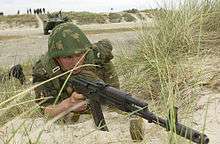
The AK-74 was equipped with a new buttstock, handguard (which retained the AKM-type finger swells) and gas cylinder. The stock has a shoulder pad different from that on the AKM, which is rubber and serrated for improved seating against the shooter. In addition, there are lightening cuts on each side of the buttstock. The buttstock, lower handguard and upper heatguard were first manufactured from laminated wood, this later changed to a synthetic, plum or dark brown colored fiberglass.
The AK-74 gas tube has a spring washer attached to its rear end designed to retain the gas tube more securely. The lower handguard is fitted with a leaf spring that reduces play in the rifle's lateral axis by keeping the wood tensioned between the receiver and the handguard retainer. The receiver remains nearly identical to that of the AKM; it is a U-shaped 1 mm (0.04 in) thick sheet steel pressing supported extensively by pins and rivets. The internal guide rails on which the bolt carrier travels are stamped and spot welded to the inside of the receiver housing. Minor changes were made to the front barrel and rear stock trunnions as well as the magazine well. All external metal surfaces are coated with a glossy black enamel paint.
Accessories
Accessories supplied with the military version of the rifle include a 6H4 or 6H5 type bayonet, a quick-loading device, three spare magazines, four 15-round stripper clips, maintenance kit, cleaning rod and sling. The bayonet is installed by slipping the muzzle ring around the flash hider and latching the handle down on the bayonet lug under the front sight base. The 6H5 AK-74 bayonet introduced in 1983 represents a further refinement of the 6H4 AKM bayonet. It introduced a radical blade cross-section, that has a flat milled on one side near the edge and a corresponding flat milled on the opposite side near the false edge.[31] The blade has a new spear point and an improved one-piece molded plastic grip making it a more effective fighting knife.[31] It also has saw-teeth on the false edge and the usual hole for use as a wire-cutter.[31]
5.45×39mm cartridge
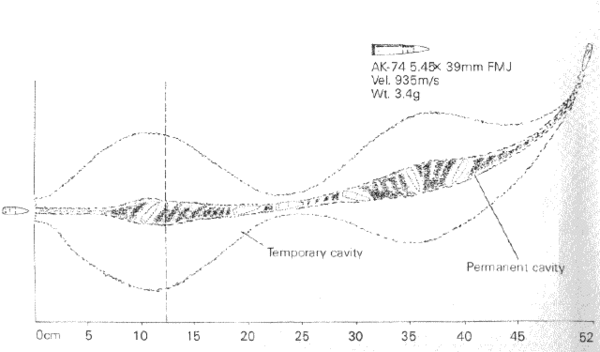
Relatively small sized, light weight, high velocity military service cartridges like the 5.45×39mm allow a soldier to carry more ammunition for the same weight compared with their larger and heavier predecessor cartridges, have favourable maximum point-blank range or "battle zero" characteristics and produce relatively low bolt thrust and free recoil impulse, favouring light weight arms design and automatic fire accuracy.[32] Tests measured the free recoil energy delivered by the 5.45×39mm AK-74 rifle at 3.39 J (2.50 ft⋅lb), compared with 7.19 J (5.30 ft⋅lb) delivered by the 7.62×39mm in the AKM.[33]
Early 5.45×39mm ballistics tests demonstrated a pronounced tumbling effect with high speed cameras.[34] Some Western authorities believed this bullet was designed to tumble in flesh to increase wounding potential. At the time, it was believed that yawing and cavitation of projectiles were primarily responsible for tissue damage. Martin Fackler conducted a study with an AK-74 assault rifle using live pigs and ballistic gelatin; "The result of our preset test indicate that the AK-74 bullet acts in the manner expected of a full-metal-cased military ammunition - it does not deform or fragment when striking soft tissues".[35] Most organs and tissue were too flexible to be severely damaged by the temporary cavity effect caused by yaw and cavitation of a projectile. With the 5.45 mm bullet, tumbling produced a temporary cavity twice, at depths of 100 mm (3.9 in) and 350 mm (13.8 in). This is similar to (but more rapid than) modern 7.62×39mm ammunition and to (non-fragmenting) 5.56×45mm NATO ammunition.
Magazines
The original steel-reinforced 30-round AK-74 detachable box magazine was similar to that of the AKM, except for minor dimensional changes required by the 5.45×39mm cartridge. These rust-colored magazines are often mistakenly identified as being made of Bakelite (a phenolic resin), but were actually fabricated from two-parts of AG-S4 molding compound (a glass-reinforced phenol-formaldehyde binder impregnated composite), assembled using an epoxy resin adhesive.[36][37][38] Noted for their durability, these magazines did however compromise the rifle's camouflage and lacked the small horizontal reinforcing ribs running down both sides of the magazine body near the front that were added on all later AK-74 magazine generations.[38] A second generation steel-reinforced dark-brown (color shades vary from maroon to plum to near black) 30-round magazine was introduced in the early 1980s, fabricated from ABS plastic. The third generation steel-reinforced 30-round AK-74 magazine is similar to the second generation, but is darker colored and has a matte nonreflective surface finish. With the introduction of the AK-74M the fourth generation of steel-reinforced matte true black nonreflective surface finished 30-round AK-74 magazines was introduced. All AK-74 magazines have a raised horizontal rib on each side of the rear lug to prevent their use in a 7.62×39mm AK. The magazines can be quickly recharged from stripper clips. The empty weight of a 30-round AK-74 box magazine is 230 g (8.1 oz). The 45-round plastic box magazine of the RPK-74 light machine gun[39] is also interchangeable with that of the AK-74. The empty weight of a 45-round RPK-74 box magazine is 300 g (11 oz). Further 60-round and later 50-round quad-stack 5.45×39mm casket magazines were developed.[40]
The transition to mainly plastic magazines and the relatively small sized, light weight, high velocity 5.45×39mm cartridge yielded a significant weight reduction and allow a soldier to carry considerably more rounds for the same weight compared with the previous Soviet AK-47 and AKM and later 7.62×39mm chambered AK platform assault rifles.[13]
| Rifle | Cartridge | Cartridge weight | Weight of empty magazine | Weight of loaded magazine | Max. 10.12 kg (22.3 lb) ammunition load* |
|---|---|---|---|---|---|
| AK-47 (1949) | 7.62×39mm | 16.3 g (252 gr) | slab-sided steel 430 g (0.95 lb) |
30-rounds 916 g (2.019 lb)[41] |
11 magazines for 330 rounds 10.08 kg (22.2 lb) |
| AKM (1959) | 7.62×39mm | 16.3 g (252 gr) | ribbed stamped-steel 330 g (0.73 lb) |
30-rounds 819 g (1.806 lb)[42][43] |
12 magazines for 360 rounds 9.83 kg (21.7 lb) |
| AK-103 (1994) | 7.62×39mm | 16.3 g (252 gr) | steel-reinforced plastic 250 g (0.55 lb) |
30-rounds 739 g (1.629 lb)[42][43] |
13 magazines for 390 rounds 9.61 kg (21.2 lb) |
| AK-74 (1974) | 5.45×39mm | 10.7 g (165 gr) | steel-reinforced plastic 230 g (0.51 lb) |
30-rounds 551 g (1.215 lb)[43][44] |
18 magazines for 540 rounds 9.92 kg (21.9 lb) |
Note: All, 7.62×39mm AK magazines are backwards compatible with older AK variants.
Note *: 10.12 kg (22.3 lb) is the maximum amount of ammo that the average soldier can comfortably carry. It also allows for best comparison of the three most common 7.62×39mm AK platform magazines and the 5.45×39mm AK-74 magazine.
Variants
In addition to "N" versions with a side dovetail rail for mounting optical sights, there are several variations on the AK-74.
AKS-74

The AKS-74 ("S"—Russian: складной; Skladnoy, or "folding"), is a variant of the AK-74 equipped with a side-folding metal shoulder stock, designed primarily for use with air assault infantry and developed alongside the basic AK-74. Unlike the AKMS's somewhat fragile underfolding stock (modeled after the MP 40 submachine gun stock), the AKS-74 stock is fabricated from stamped sheet metal struts, machine pressed into a "U" shape and assembled by punch fit and welding. The stock has a triangular shape; it lacks the folding shoulder pad found on the AKMS stock and is folded to the left side of the receiver. The hinged stock is securely locked in its extended position by a spring-loaded button catch located at the rear of the receiver. When folded, the stock is held closed by a spring-loaded capture hook situated on the left side at the front of the receiver housing. A rear-mounted sling swivel is also provided on the right side at the beginning of the stock frame. It retains the pistol grip reinforcement plate the AKMS used, though due to the less complex rear trunnion, only has one riveting hole in place of the three on the AKMS.

AK-74M
In 1991 the Izhmash factory in the city of Izhevsk began full-scale production of a modernized variant of the AK-74—the AK-74M ("M"—Russian: Модернизированный; Modernizirovanniy or "modernized") assault rifle that offers more versatility compared with its predecessor. Apart from several minor improvements, such as a lightened bolt and carrier assembly to reduce the impulse of the gas piston and bolt carrier during firing, the rifle features a new glass-filled polyamide stock that retains the shape of the original AK-74 fixed laminated wood stock, but side-folds to the left like the skeletonized AKS-74 buttstock. As a result, pistol grip reinforcement plates that were once exclusively used on the folding stock variants are standard on all AK-74Ms. Additionally the AK-74M features an improved muzzle device with extended collar and threads to reduce play and a machine cut beneath to allow easier cleaning rod removal, a reinforced smooth dust cover and a redesigned guide rod return spring retainer that allows firing the GP-25, GP-30 and GP-34 underslung grenade launchers without having to use the previously necessary additional receiver cover fastener. To reduce production costs, barrel hardware, such as the front sight base and gas block, are dimple pressed on to the barrel instead of pinned on (commercial semi-auto variants are still pinned on to maintain user serviceability). Other economic changes include omission of lightening cuts on the front sight block and gas piston as well as a stamped gas tube release lever, replacing the milled one. The bullet guide and bolt guide were also separated, with the bolt guide becoming a simple bump held in place on the left side of the receiver with an additional rivet (it's often called a "bump rivet" because of this) making it easier to replace in case of wear. Each AK-74M is fitted with a side-rail bracket for mounting optics that is a simplified version of the 74N mount with less machining cuts. The AK-74M would have been adopted by the Soviet Union as the standard service rifle, and has been accepted as the new service rifle of the Russian Federation.
AK-74MR UUK (Universal Upgrade Kit)

An AK-74M universal upgrade kit consisting of a new safety, dust cover and furniture featuring improved ergonomics and rails to attach accessories like aiming optics, optoelectronic sights, laser sights, weapon lights and vertical fore grips and a new muzzle device had its official debut on May 9, 2015 in Moscow as part of the 2015 Moscow Victory Day Parade.[45][46]
The Kalashnikov Concern has further developed three sets of additional equipment for the modernization of 5.45×39mm and 7.62×39mm chambered AK-pattern assault rifles for normal military units, reconnaissance units, and special forces units.[47] The Kalashnikov Concern announced it has a contract with the Russian Ministry of Defence to deliver upgrade kits for their AK-74M assault rifles.[48]
AKS-74U
| AKS-74U | |
|---|---|
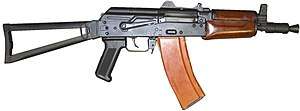 AKS-74U | |
| Type | Carbine Personal defense weapon |
| Place of origin | Soviet Union Russia |
| Service history | |
| In service | 1979–present |
| Used by | See Users |
| Wars | Soviet–Afghan War Transnistria War Tajikistan Civil War First Chechen War Second Chechen War War in Afghanistan Russo-Georgian War Iraqi Civil War (2014–2017) Syrian Civil War War in Donbass |
| Production history | |
| Designer | Mikhail Kalashnikov |
| Designed | 1970s |
| Manufacturer | Tula Arms Plant |
| Produced | 1979–1993 |
| Specifications (Bharat) | |
| Mass | 2.7 kg (6.0 lb) |
| Length | 730 mm (28.7 in) (stock extended) 490 mm (19.3 in) (stock folded) |
| Barrel length | 206.5 mm (8.1 in) |
| Cartridge | 5.45×39mm |
| Action | Gas-operated, rotating bolt |
| Rate of fire | Cyclic: 700-735 rounds/min Practical: Automatic: 100 rounds/min Semi-auto: 40 rounds/min |
| Muzzle velocity | 735 m/s (2,411 ft/s) |
| Effective firing range | 300–400 m (330–440 yd) |
| Feed system | 20 or 30-round AK-74 or 45-round RPK-74 detachable box magazine or 60-round casket magazine |
| Sights | Adjustable iron sights, front post and U-shaped flip rear notch |
In 1973, a design competition (codenamed "Modern"—Модерн) was started[49] for the adoption of a fully automatic carbine.
This was no doubt inspired by observing the US experience in Vietnam with the XM177. The Soviet planners also drew from the unsolicited design AO-46 built in 1969 by Peter Andreevich Tkachev, which weighed only 1.9 kg. The TTT specifications required a weight no greater than 2.2 kg (4.9 lb), a length of 75 cm (29.5 in)/45 cm (17.7 in) with the stock unfolded/folded, and an effective firing range of 500 m (547 yd). The competition was joined by designs of M.T. Kalashnikov (PP1), I.Y. Stechkin (TKB-0116), S.G. Simonov (AG-043), A.S. Konstantinov (AEK-958), and Yevgeny Dragunov (who called his model "MA"). Kalashnikov also presented an additional design (A1-75) which differed from PP1 by having a modified muzzle for flash and noise suppression.[50]
In 1977, the GRAU decided to adopt Kalashnikov's model, which was largely a shortened AKS-74, because its performance was no worse than the competition, and promised significant production cost savings by utilizing existing equipment for the AK-74 line. A final round of large scale testing with Kalashnikov's model was performed by airborne divisions in the Transcaucasian Military District in March 1977. The AKS-74U ("U"—Russian: укороченный; Ukorochenniy, or "shortened") was officially adopted in 1979, and given the official, but seldom used GRAU designation 6P26.[51] In 1993 production stopped.[52]
The AKS-74U bridges the tactical deployment gap between a submachine gun and an assault rifle. It was intended for use mainly with special forces, airborne infantry, rear-echelon support units, helicopter and armored vehicle crews. It has been augmented and replaced by various submachine guns, and the less compact AK-105 carbine in Russian military service. It is commonly used by law enforcement; for example, each urban police foot patrol is issued at least one.
The rifle's compact dimensions, compared with the AKS-74, were achieved by using a short 206.5 mm (8.1 in) barrel (this forced designers to simultaneously reduce the gas piston operating rod to an appropriate length). Due to the shortening of the operating mechanism the cyclic rate of fire rose slightly to around 700-735 rounds per minute. In order to effectively stabilize projectiles, the barrel's twist rate was increased from 200 mm (1:7.87 in) or 37 calibers rifling twist rate to 160 mm (1:6.3 in) or 29.6 calibers rifling twist rate to adapt the AKS-74U for muzzle velocities of 720 m/s (2,362 ft/s) and higher. A new gas block was installed at the muzzle end of the barrel with a muzzle booster, which features an internal expansion chamber inside the cylindrical section of the booster while the conical end acts as a nozzle to increase net pressure inside the gas chamber by supplying an increased amount of propellant gasses from the barrel. The chrome-lined muzzle booster also burns any remaining propellant, which would normally reduce muzzle blast. However, due to the extremely short barrel and conical end of the booster, the muzzle blast is nevertheless extremely large and visible. The muzzle device locks into the gas block with a spring-loaded detent pin and features two parallel notches cut into the edge of the flash hider cone, used for unscrewing it using the cleaning rod. Unlike most Kalashnikov variants there is no provision to store the cleaning rod under the barrel. The front sight was integrated into the gas block/forward sling loop.
The sight height above the bore axis is also approximately 3 mm (0.1 in) higher than the AK-74, due to the combined front sight/gas block, rear sight configuration. The AKS-74U has a different rear sight composed of a U-shaped flip sight on the top cover instead of the standard sliding notch tangent rear sight. This rear sight has two settings: "П" standing for постоянная (constant) corresponding to a 350 m (383 yd) "point-blank range" battle zero setting and "4-5" (used for firing at distances between 400–500 m (437–547 yd)).[53] The rear sight is housed in a semi-shrouded protective enclosure that is riveted to the receiver's spring-loaded top cover. This top cover hinges from a barrel trunnion (hinging where the rear sight on a normal AK74 is located), pivoting forward when opened, which also works to unlock the gas tube cover. Both the gas tube and handguard are also of a new type and are wider and shorter than the analogous parts in the AKS-74.
For the AKS-74s combined with the 7N6 or 7N10 service cartridges the 350 m battle zero setting limits the apparent "bullet rise" within approximately −5 to +42 cm (−2.0 to 16.5 in) relative to the line of sight. Soldiers are instructed to fire at any target within this range by simply placing the sights on the center of mass (the belt buckle) of the enemy target. Any errors in range estimation are tactically irrelevant, as a well-aimed shot will hit the torso of the enemy soldier.
.jpg)
The AKS-74U is significantly more maneuverable in tight quarters than the AKS-74; however, the significant decline in muzzle velocity to 735 m/s (2,411 ft/s) resulted in a 100 m (109 yd) reduction in effective range to 400 m (437 yd) (the effective hitting distance for a "running"-type silhouette target was reduced from 625 m (684 yd) to 360 m (394 yd)). The AKS-74U cannot mount a bayonet or standard under-barrel grenade launcher. However, a suppressed 30 mm BS-1 grenade launcher was developed specifically for that platform that fires a high-explosive dual purpose (HEDP) grenade. The grenades for the BS-1 are launched by special blank cartridges that are inserted into the grenade launcher via a detachable magazine. The majority of AKS-74U carbines were manufactured at the Tula Arms Factory rather than Izhmash. There were some accessories produced for the AKS-74U including a plastic thigh holster and (shorter than standard) 20-round AK-74 type magazines. The rifle utilizes a proprietary 25 mm wide sling that differs from the standard 35 mm AK sling also in construction. The AKS-74U also exists in a version featuring modernized synthetic furniture made from a black, glass-filled polyamide. The AKS-74U was also used as the basis for several other unique weapons, including the bullpup OTs-14 Groza specialist carbine which is now in limited service in the Russian military, and the Gepard series of multi-caliber submachine guns (none of which evolved past prototype stage).
In the United States, the AKS-74U is called a "Krinkov". The origin of this term is uncertain. A hypothesis was circulating that the name came from the mujahideen who supposedly had captured a high-ranking Soviet officer armed with an AKS-74U, and that they had named it after him. However, investigation by Patrick Sweeney could not confirm this hypothesis, for no Soviet officer with a resembling name was captured in Afghanistan.[54] US journalist C. J. Chivers reported that the gun was nicknamed "the Osama" in jihadist circles, after Osama bin Laden was photographed next to an AKS-74U.[10] Research by The Firearm Blog published in 2016 suggests that the name "Krinkov" is actually a Pashtun invention that came to the United States with accounts of the Mujahideen.[55]
The AKS-74U is approximately 3 oz (85 g) lighter than the NATO equivalent XM177, and 10.2 in (260 mm) shorter with the stock folded. Due to the fact that the AKS-74U is moderately concealable with its stock folded and capable of easily defeating IIIa soft body armor, it continues to be able to perform the role of a modern Personal Defense Weapon, despite being designed in the 1970s.
Specialized variants
The AK-74 is also available in several "night-fighting" configurations, equipped with a side-rail used to mount sights. These variants, the AK-74N, AKS-74N and AKS-74UN can be used in conjunction with NSPU and NSPU-3 (1PN51)[56] night sights, as well as optical sights such as the USP-1 (1P29). The variants designated AK-74N2 and AKS-74N2 can use the multi-model night vision sight NSPUM (1PN58).[57] The AKS-74UB ("B"—Russian: бесшумный; Besshumniy or "silent") is a sound-suppressed variant of the AKS-74U adapted for use with the PBS-4 suppressor (used in combination with subsonic 5.45×39mm Russian ammunition).[58] Very little is known about this model.
Successors
AK-100 series
The AK-74M was also the basis for the new Russian AK-100 family of Kalashnikov firearms: the AK-101 assault rifle and AK-102 carbine (both chambered for the NATO-standard 5.56×45mm NATO cartridge), AK-103 assault rifle and AK-104 carbine (both chambered for the 7.62×39mm round) and the 5.45×39mm AK-105 carbine. The AK-101, AK-102, AK-103 and AK-104 are destined primarily for export, while the AK-105 is slated to replace the AKS-74U with the Russian Armed Forces. Additionally, the 5.45×39mm AK-107 and 5.56×45mm NATO AK-108 rifles have a balanced recoil system to reduce felt recoil and muzzle rise. This balanced recoil system is derived from the AL-7 rifle.
AK-12
In 2010, the AK-12 series of proposed prototype models were unveiled. They differed in weight, introduced a new recoil compensation technology and improved ergonomics. The rear iron sight element was rail-mounted and moved to the back of the upper receiver to lengthen the sight line, and the full length of the weapon featured a Picatinny rail for mounting accessories such as aiming optics on top. The hand guard features Picatinny rails on both sides and its underside for mounting accessories like tactical lights, laser sights and grenade launchers. Throughout its development and evaluation stage the multiple modifications were applied to meet Russian military standards, as well as to improve upon the "range of defects" that were discovered on prototype models and to addresses concerns regarding the cost of earlier prototypes. In September 2016 the prototype models were replaced by the final production models of the AK-12 (chambered in 5.45×39mm]) and AK-15 (chambered in 7.62×39mm) assault rifles. Parallel developments are the RPK-16 light machine gun and the MA compact assault rifle (both chambered in 5.45×39mm). The AK-12, AK-15, RPK-16 and MA production models technically stronger resemble the AK-74M, AK-100 series and RPK-74M than the earlier prototypes and the arms manufacturer Kalashnikov concern hopes they will replace these Russian service guns.
In late 2016 it was reported the AK-12 production model was undergoing troop trials with the Russian Army, where it competes against the Degtyarov A-545 balanced action assault rifle in Ratnik program trials. The AK-12 completed its operational testing and passed military field tests in June 2017, paving the way to Russian Army adoption, potentially under the Ratnik program.[59][60][61] Both AK-12 and AK-15 completed testing in December 2017.
In January 2018 it was announced that the AK-12 and AK-15 have been adopted by the Russian military.[62]
Gallery
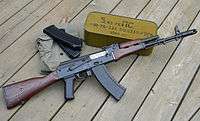 MPI-KM-74 with magazines and 5.45×39mm (7N6) ammunition can.
MPI-KM-74 with magazines and 5.45×39mm (7N6) ammunition can. Russian Airborne Troops (VDV) cadets wielding AK-74M rifles during the 2005 Annual Moscow Victory Parade.
Russian Airborne Troops (VDV) cadets wielding AK-74M rifles during the 2005 Annual Moscow Victory Parade.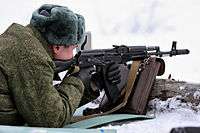 VDV soldier firing an AK-74M rifle.
VDV soldier firing an AK-74M rifle.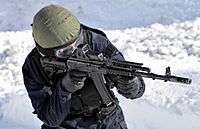 A modernized AK-74 displayed in 2013 by Internal troops special units.
A modernized AK-74 displayed in 2013 by Internal troops special units.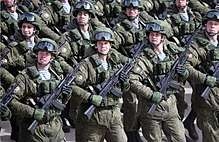 Modernized AK-74M assault rifles displayed in 2015 by VDV troops.
Modernized AK-74M assault rifles displayed in 2015 by VDV troops.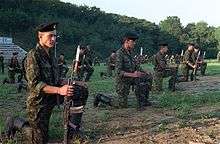 Soviet naval infantrymen in 1990 with bayonet-equipped AKS-74 rifles.
Soviet naval infantrymen in 1990 with bayonet-equipped AKS-74 rifles.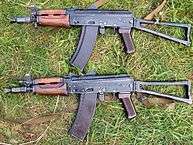 AKS-74U carbines.
AKS-74U carbines.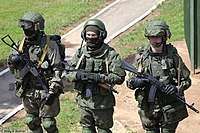 Left to right; Russian soldiers with AS Val, AKS-74U and AK-74M.
Left to right; Russian soldiers with AS Val, AKS-74U and AK-74M.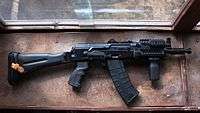 AKS 74U tuned with polymer furniture.
AKS 74U tuned with polymer furniture. Captured AKS-74U in the background as Hamid Mir interviews Osama bin Laden in the late 1990s
Captured AKS-74U in the background as Hamid Mir interviews Osama bin Laden in the late 1990s 'Обвес' Universal Upgrade Kit for the AK-74M and AK-100 rifle family
'Обвес' Universal Upgrade Kit for the AK-74M and AK-100 rifle family
Accuracy potential
The following table represents the Russian method for determining accuracy and it is far more complex than Western methods. In the West, one fires a group of shots into the target and then simply measure the overall diameter of the group. The Russians on the other hand, fire a group of shots into the target. They then draw two circles on the target: one for the maximum vertical dispersion of hits and one for the maximum horizontal dispersion of hits. They then disregard the hits on the outer part of the target and only count half of the hits (50% or R50) on the inner part of the circles. This dramatically reduces the overall diameter of the groups. They then use both the vertical and horizontal measurements of the reduced groups to measure accuracy. This circular error probable method used by the Russian and other European militaries cannot be converted and is not comparable to US military methods for determining rifle accuracy. When the R50 results are doubled the hit probability increases to 93.7%.
| AK-74 short burst dispersion with 5.45×39mm 7N6 service ammunition[63] | ||||
|---|---|---|---|---|
| Range | Vertical accuracy of fire (R50) | Horizontal accuracy of fire (R50) | Remaining bullet energy | Remaining bullet velocity |
| 0 m (0 yd) | 0 cm (0.0 in) | 0 cm (0.0 in) | 1,328 J (979 ft⋅lbf) | 880 m/s (2,887 ft/s) |
| 100 m (109 yd) | 6 cm (2.4 in) | 8 cm (3.1 in) | 1,089 J (803 ft⋅lbf) | 800 m/s (2,625 ft/s) |
| 200 m (219 yd) | 12 cm (4.7 in) | 16 cm (6.3 in) | 853 J (629 ft⋅lbf) | 705 m/s (2,313 ft/s) |
| 300 m (328 yd) | 18 cm (7.1 in) | 24 cm (9.4 in) | 657 J (485 ft⋅lbf) | 619 m/s (2,031 ft/s) |
| 400 m (437 yd) | 24 cm (9.4 in) | 32 cm (12.6 in) | 500 J (370 ft⋅lbf) | 540 m/s (1,772 ft/s) |
| 500 m (547 yd) | 30 cm (11.8 in) | 40 cm (15.7 in) | 373 J (275 ft⋅lbf) | 466 m/s (1,529 ft/s) |
| 600 m (656 yd) | 36 cm (14.2 in) | 48 cm (18.9 in) | 255 J (188 ft⋅lbf) | 385 m/s (1,263 ft/s) |
| 700 m (766 yd) | 42 cm (16.5 in) | 56 cm (22.0 in) | 196 J (145 ft⋅lbf) | 338 m/s (1,109 ft/s) |
| 800 m (875 yd) | 48 cm (18.9 in) | 64 cm (25.2 in) | 157 J (116 ft⋅lbf) | 303 m/s (994 ft/s) |
| 900 m (984 yd) | 55 cm (21.7 in) | 73 cm (28.7 in) | 137 J (101 ft⋅lbf) | 283 m/s (928 ft/s) |
| 1,000 m (1,094 yd) | 62 cm (24.4 in) | 82 cm (32.3 in) | 118 J (87 ft⋅lbf) | 262 m/s (860 ft/s) |
- R50 means the closest 50 percent of the shot group will all be within a circle of the mentioned diameter.
In general, this is more accurate than the AK-47 and the AKM. The vertical and horizontal mean (R50) deviations with service ammunition at 800 m (875 yd) for four Russian rifles are:
| SKS, AK-47, AKM, and AK-74 dispersion at 800 m (875 yd) | |||
|---|---|---|---|
| Rifle | Firing mode | Vertical accuracy of fire (R50) | Horizontal accuracy of fire (R50) |
| SKS (1945) | semi-automatic | 38 cm (15.0 in) | 29 cm (11.4 in) |
| AK-47 (1949) | semi-automatic | 49 cm (19.3 in) | 34 cm (13.4 in) |
| AK-47 (1949) | short burst | 76 cm (29.9 in) | 89 cm (35.0 in) |
| AKM (1959) | short burst | 64 cm (25.2 in) | 90 cm (35.4 in) |
| AK-74 (1974) | short burst | 48 cm (18.9 in) | 64 cm (25.2 in) |
The single-shot hit-probability on the NATO E-type Silhouette Target (a human upper body half and head silhouette) of the AK-47, AK-74 and M16A1 and M16A2 assault rifles were measured by the US military under ideal proving ground conditions in the 1980s as follows:
| Single-shot hit-probability on Crouching Man (NATO E-type Silhouette) Target[64] | ||||||||||
|---|---|---|---|---|---|---|---|---|---|---|
| Rifle | Chambering | Hit-probability (With no range estimation or aiming errors) | ||||||||
| 50 meters | 100 meters | 200 meters | 300 meters | 400 meters | 500 meters | 600 meters | 700 meters | 800 meters | ||
| AK-47 (1949) | 7.62×39mm | 100% | 100% | 99% | 94% | 82% | 67% | 54% | 42% | 31% |
| AK-74 (1974) | 5.45×39mm | 100% | 100% | 100% | 99% | 93% | 81% | 66% | 51% | 34% |
| M16A1 (1967) | 5.56×45mm NATO M193 | 100% | 100% | 100% | 100% | 96% | 87% | 73% | 56% | 39% |
| M16A2 (1982) | 5.56×45mm NATO SS109/M855 | 100% | 100% | 100% | 100% | 98% | 90% | 79% | 63% | 43% |
Under worst field exercise circumstances, due to range estimation and aiming errors, the hit probabilities for the tested assault rifles were drastically reduced with differences without operational significance.
AKS-74U
| AKS-74U short burst dispersion with 5.45×39mm 7N6 service ammunition[65] | ||||
|---|---|---|---|---|
| Range | Vertical accuracy of fire (R50) | Horizontal accuracy of fire (R50) | Remaining bullet energy | Remaining bullet velocity |
| 0 m (0 yd) | 0 cm (0.0 in) | 0 cm (0.0 in) | 926 J (683 ft⋅lbf) | 735 m/s (2,411 ft/s) |
| 100 m (109 yd) | 10 cm (3.9 in) | 10 cm (3.9 in) | 706 J (521 ft⋅lbf) | 642 m/s (2,106 ft/s) |
| 200 m (219 yd) | 20 cm (7.9 in) | 20 cm (7.9 in) | 539 J (398 ft⋅lbf) | 561 m/s (1,841 ft/s) |
| 300 m (328 yd) | 30 cm (11.8 in) | 30 cm (11.8 in) | 402 J (296 ft⋅lbf) | 484 m/s (1,588 ft/s) |
| 400 m (437 yd) | 40 cm (15.7 in) | 40 cm (15.7 in) | 294 J (217 ft⋅lbf) | 414 m/s (1,358 ft/s) |
| 500 m (547 yd) | 50 cm (19.7 in) | 50 cm (19.7 in) | 216 J (159 ft⋅lbf) | 355 m/s (1,165 ft/s) |
- R50 means the closest 50 percent of the shot group will all be within a circle of the mentioned diameter.
Users






























Former users



.png)

Non-State Users

See also
Notes
- https://web.archive.org/web/20110804035337/http://www.izhmash.ru/eng/arc/021205.shtml Presentation of the unique Kalashnikov small arms collection in the Moscow Kremlin Museum
- Small Arms Survey (2003). "Dangerous Supply: Small Arms and Conflict in the Republic of Georgia" (PDF). Small Arms Survey 2003: Development Denied. Oxford University Press. p. 197. Archived from the original on 2018-08-29. Retrieved 2018-08-29.
- http://www.omnia.ie/index.php?navigation_function=2&navigation_item=b0c57d06aebc6ea7ea2a62aa2fbb88dd&repid=2
- "militaryparitet.com (Russian)". Archived from the original on 1 March 2012. Retrieved 16 November 2014.
- "Modern Firearms". 2010-10-27. Archived from the original on 25 October 2014. Retrieved 16 November 2014.
- "Izhmash—manufacturer's website 5.45 mm Kalashnikov assault rifles AK74M, AK105". Archived from the original on 21 February 2015. Retrieved 16 November 2014.
- https://fas.org/man/dod-101/sys/land/row/weg2001.pdf Archived 2015-04-25 at the Wayback Machine OPFOR Worldwide Equipment Guide, Sep 2001, DEPARTMENT OF THE ARMY, TRADOC DCSINT, Threat Support Directorate, 700 Scott Avenue, Bldg 53, FORT LEAVENWORTH, KS, 66027-1323, page 1-3
- Автомат Калашникова АКС-74У [Kalashnikov rifle AKS-74U] (in Russian). Archived from the original on 2014-11-02. Retrieved 2014-11-02.
- Woźniak, Ryszard: Encyklopedia najnowszej broni palnej—tom 1 A-F, page 25. Bellona, 2001.
- C. J. Chivers (12 October 2010). The Gun. Simon & Schuster. pp. 382–383. ISBN 978-1-4391-9653-3. Retrieved 5 July 2013.
- Cutshaw, Charlie: The New World of Russian Small Arms & Ammo, page 92. Paladin Press, 1998.
- McNab, Chris: The AK47 (Weapons of War), page 25. Spellmount Publishers, 2001.
- "Archived copy". Archived from the original on 2014-02-21. Retrieved 2014-11-16.CS1 maint: archived copy as title (link) "AK-74 – Kalashnikov assault rifle, caliber 5.45 mm. In 1967, pursuant to the Resolution of the CPSU Central Committee and the USSR Council of Ministers, a competition was organized to design an assault rifle fit to use the new 5.45-mm cartridge. The AK-74 was designed by А. D. Kryakushin's group under the designer supervision of M. T. Kalashnikov. Based on the competition results, this assault rifle was included in the inventory in 1974 as part of the 5.45-mm small arms complex. The cartridge used in the AK-74 weighs 1.5 times less as compared with the 7.62-mm cartridge. The soldier can carry 1.5 times more cartridges without increasing the weight of the portable reserve ammunition. In addition, the bullet speed of the 5.45-mm caliber is higher."
- Kokalis, Peter: Weapons Tests And Evaluations: The Best Of Soldier Of Fortune, page 45. Paladin Press, 2001.
- http://www.military-today.com/firearms.pdf Archived 2015-05-13 at the Wayback Machine "The AK-74 has improved firing accuracy over the AKM. This weapon retains all advantages and disadvantages of Kalashnikov design, including reliability, ruggedness, simplicity of operation and maintenance. This weapon do not jams or misfires in worst conditions possible. Also it has reliable extraction even with dirty chamber and cases. Its drawbacks are poor balance and ergonomics, as well as inferior firing accuracy to most Western weapons." Firearms E-book Military-Today.com 2010. page 25
- http://www.military-today.com/firearms/ak_74.htm Archived 2015-01-09 at the Wayback Machine "The AK-74 has improved firing accuracy over the AKM. This weapon retains all advantages and disadvantages of Kalashnikov design, including reliability, ruggedness, simplicity of operation and maintenance. This weapon do not jams or misfires in worst conditions possible. Also it has reliable extraction even with dirty chamber and cases. Its drawbacks are poor balance and ergonomics, as well as inferior firing accuracy to most Western weapons."
- Woźniak, 26
- Kokalis, 46
- Hogg, Ian & Weeks, John. Military Small Arms of the 20th Century, 7th Edition Krause Publications. (2000) ISBN 0-87341-824-7.
- "AK-74 Muzzle Brakes/Compensators". Archived from the original on 10 January 2019. Retrieved 16 November 2014.
- Gordon Rottman (24 May 2011). The AK-47: Kalashnikov-series Assault Rifles. Osprey Publishing. pp. 42–. ISBN 978-1-84908-835-0. Archived from the original on 3 January 2014. Retrieved 24 December 2011.
- "Using a 400 meter zero with 5.45x39". Archived from the original on 29 November 2014. Retrieved 16 November 2014.
- "5.45x39 Optics". RussianOptics.net. Archived from the original on 3 April 2015. Retrieved 27 March 2015.
- "Red Dot and Collimator Optics". RussianOptics.net. Archived from the original on 25 March 2015. Retrieved 27 March 2015.
- 1P29 4.0x Magnification Archived 2013-12-04 at the Wayback Machine. Russianoptics.net
- "1P29 Universal sight for small arms NPZ Novosibirsk Instrument-Making Plant". Archived from the original on 29 November 2014. Retrieved 16 November 2014.
- "Image collection of 1P29 sights". Archived from the original on 2014-11-29. Retrieved 16 November 2014.
- "Dedicated 5.45x39 Optics". Archived from the original on 29 November 2014. Retrieved 16 November 2014.
- 1P78 Kashtan 2.8x Magnification Archived 2013-12-07 at the Wayback Machine. Russianoptics.net
- "1P78 rifle sight NPZ Novosibirsk Instrument-Making Plant". Archived from the original on 29 November 2014. Retrieved 16 November 2014.
- Cobb, Ralph E. (2013-12-29). "AK Bayonets 101 - The Four Basic Types". worldbayonets.com. AK74 Bayonet. Archived from the original on 2015-03-24. Retrieved 2015-03-17.
- "Assault Rifles and Their Ammunition: History and Prospects by Anthony G. Williams". Archived from the original on 5 November 2017. Retrieved 16 November 2014.
- Holt Bodinso (Sep 2008). "The Russians are coming! The Russians are coming! Or maybe the Polish". Guns Magazine. Archived from the original on 20 October 2014. Retrieved 16 November 2014.
- Korac, Zelimir (2001). "Terminal ballistics of the Russian AK 74 assault rifle: Two wounded patients and experimental findings". Military Medicine. Archived from the original on 2008-03-10. Retrieved 2007-09-25.
- "Wounding Potential of the AK-74 Assault Rifle" (PDF). Archived from the original (PDF) on 2009-02-19. Retrieved 2007-09-25.
- "Kalashnikovs 3 of the best" (PDF). "Shotgun News" magazine, Vol. 59 Issue no. 12 - May, 2005. Archived (PDF) from the original on 23 September 2015. Retrieved 10 April 2015.
- Grezin, V. M. (1969). "Elastic characteristics of AG-4S glass-reinforced plastic under short-time and long-time loads". Polymer Mechanics. 2 (2): 188–190. doi:10.1007/BF00867112.
- Kokalis, 49
- "A Guide to 5.45mm Kalashnikov Magazine Types". Archived from the original on 6 November 2014. Retrieved 16 November 2014.
- "AK74 Quad Stack 50 round magazine". Archived from the original on 2015-05-29. Retrieved 2015-09-20.
- Dockery, Kevin (2007). Future Weapons. p. 102. ISBN 978-0-425-21750-4.
- "Ak 47 Technical Description - Manual". Scribd.com. 2010-09-30. Archived from the original on 2012-03-28. Retrieved 2012-08-23.
- Dockery, Kevin (2007). Future Weapons. p. 102.
- "Официальный сайт группы предприятий "ИЖМАШ"". Izhmash.ru. 2001-09-02. Archived from the original on 2014-10-06. Retrieved 2012-08-23.
- "New AK-74M to make debut at Moscow V-Day parade". RT. 6 May 2015. Archived from the original on 8 May 2015. Retrieved 8 May 2015.
- "Kalashnikov to show off upgraded AK-74M at Victory Day parade (including image)". TASS. 7 May 2015. Retrieved 9 May 2015.
- "An improved Kalashnikov rifle will be on display at the Victory Day Parade A universal upgrade kit improves the weapon's effectiveness by 1.5 times". Rostec. 6 May 2015. Archived from the original on 11 May 2015. Retrieved 9 May 2015.
- "Russian Armed Forces Upgrade Kit for AK-74M Wednesday, June 17, 2015". Archived from the original on June 24, 2016. Retrieved May 18, 2016.
- By Soviet TTT (тактико-технические требования) order number 008407 from 19.17.1973
- "The Krinks that never were, AKSU trial rifles". Archived from the original on 2016-08-02. Retrieved 2016-08-09.
- Monetchikov, pp. 165–177.
- "Experimentation, use, and variants of the Russian AKS74U". Archived from the original on 2016-08-02. Retrieved 2016-08-09.
- "AKS-74U Kalashnikov shortened assault rifle". Archived from the original on 2 November 2014. Retrieved 16 November 2014.
- Patrick Sweeney (2009-01-13). The Gun Digest Book of the AK & SKS: A Complete Guide to Guns, Gear and Ammunition. Gun Digest Books. p. 236. ISBN 978-0-89689-678-9. Archived from the original on 2016-06-24. Retrieved 2016-01-05.
- "Krinkov: The definite origin". 2016-01-18. Archived from the original on 20 January 2016. Retrieved 18 January 2016.
- ИЗДЕЛИЕ 1ПН51 ТЕХНИЧЕСКОЕ ОПИСАНИЕ И ИНСТРУКЦИЯ ПО ЭКСПЛУАТАЦИИ [PRODUCT 1PN51 TECHNICAL DESCRIPTION AND OPERATING INSTRUCTIONS] (in Russian). January 1992. p. 11.
- ИЗДЕЛИЕ 1ПН58 ТЕХНИЧЕСКОЕ ОПИСАНИЕ И ИНСТРУКЦИЯ ПО ЭКСПЛУАТАЦИИ [PRODUCT 1PN58 TECHNICAL DESCRIPTION AND OPERATING INSTRUCTIONS] (in Russian). February 1991. pp. 5, 13.
- Cutshaw, 19-20
- "Russia completes trials of newest assault rifle for 'soldier of the future' combat gear". TASS. Moscow. 20 June 2017. Archived from the original on 6 July 2017. Retrieved 6 July 2017.
- "Kalashnikov AK-12 Assault Rifle Passes Field Trials". Defense World. 5 July 2017. Archived from the original on 6 July 2017. Retrieved 6 July 2017.
- Wilk, Remigiusz (4 July 2017). "AK-12 assault rifle passes field tests". IHS Jane's 360. Warsaw. Archived from the original on 6 July 2017. Retrieved 6 July 2017.
- "BREAKING: Russian Army Adopts AK-12, AK-15, AEK-971, and AEK-973 Rifles for Military Service (For Real This Time) - Thefirearmblog.com, 31 January 2018". Archived from the original on 4 June 2018. Retrieved 9 February 2018.
- Guide 5.45-mm Kalashnikov (AK74, AK74S, AK74N, AKS74N) and 5,45 mm RPK (RPK74, RPKS74, RPK74N, RPKS74N) - M .: Military publishing the Ministry of Defence of the USSR, 1982
- "TECHNICAL REPORT NO. 461 SYSTEM ERROR BUDGETS, TARGET DISTRIBUTIONS AND HITTING PERFORMANCE ESTIMATES FOR GENERAL-PURPOSE RIFLES AND SNIPER RIFLES OF 7.62 X 51 MM AND LARGER CALIBERS JONATHAN M. WEAVER, JR. LTC, INFANTRY, U.S. ARMY (RETIRED) MAY 1990 U.S. ARMY MATERIEL SYSTEMS ANALYSIS ACTIVITY ABERDEEN PROVING GROUND, MARYLAND, Page 87" (PDF). Archived (PDF) from the original on 2015-11-23. Retrieved 2016-02-24.
- Guide 5.45-mm Kalashnikov assault rifle short AKS74U (AKS74UN2) (1992)
- Jones, Richard D. Jane's Infantry Weapons 2009/2010. Jane's Information Group; 35th edition (January 27, 2009). ISBN 978-0-7106-2869-5.
- "Krinkov: The definite origin". TheFirearmBlog.com. 2016-01-18. Archived from the original on 2016-12-05. Retrieved 2016-11-30.
- "Azerbaijan starts serial production of AK-74M assault rifles basing on Russian license". APA. Archived from the original on 2011-08-23. Retrieved 2011-08-14.
- "Azerbaijan begins AK-74M production". United Press International. 12 July 2011. Archived from the original on 12 July 2011. Retrieved 2013-05-21.
- "Azerbaijan starts production of Kalashnikovs". News.az. 7 July 2011. Archived from the original on 18 March 2012. Retrieved 2013-05-21.
- "Defense & Security Intelligence & Analysis: IHS Jane's - IHS". Archived from the original on 11 August 2011. Retrieved 16 November 2014.
- Small Arms Survey (2007). "Armed Violence in Burundi: Conflict and Post-Conflict Bujumbura" (PDF). The Small Arms Survey 2007: Guns and the City. Cambridge University Press. p. 204. ISBN 978-0-521-88039-8. Archived from the original on 2018-08-27. Retrieved 2018-08-29.
- Jenzen-Jones, N.R. (September 2012). "The 100-Series Kalashnikovs: A Primer". Small Arms Review. Vol. 16 no. 3. Archived from the original on 2019-03-06. Retrieved 2019-03-06.
- https://mpk.fi/wp-content/uploads/2019/09/Intti-tutuksi-naisille_1_syksy_2019.jpg
- Bemil Chosun (2008-10-17). 신생 압하지야공화국 군의 퍼레이드 (in Korean). bemil.chosun.com. Archived from the original on 2017-08-06. Retrieved 2017-08-05.
- Anders, Holger (June 2014). Identifier les sources d'approvisionnement: Les munitions de petit calibre en Côte d'Ivoire (PDF) (in French). Small Arms Survey and United Nations Operation in Côte d'Ivoire. p. 15. ISBN 978-2-940-548-05-7. Archived (PDF) from the original on 2018-10-09. Retrieved 2018-09-05.
- Berman, Eric G. (March 2019). Beyond Blue Helmets: Promoting Weapons and Ammunition Management in Non-UN Peace Operations (PDF). Small Arms Survey/MPOME. p. 43.
- Scarlata, Paul (May 2012). "The military rifle cartridges of Burma/Myanmar". Shotgun News. Archived from the original on 2018-11-28. Retrieved 2018-11-27.
- "r/MilitaryPorn - A Nigerian Navy special forces soldier during Operation Deep Punch against Boko Haram in the Diffa region of the Republic of Niger.[571×720]". reddit. Retrieved 7 April 2020.
- US Department of Defense. "AK-74 ASSAULT RIFLE" (PDF). North Korea Country Handbook 1997, Appendix A: Equipment Recognition. p. A-75.
- "North Korean Small Arms (Democratic People's Republic of Korea)". Small Arms Review. Vol. 16 no. 2. June 2012. Archived from the original on 2019-02-02. Retrieved 2019-02-03.
- https://www.tactical-life.com/firearms/rifles/north-korean-ak-rifles/
- "Modern Firearms". Archived from the original on 14 September 2010. Retrieved 16 November 2014.
- "Archived copy". Archived from the original on 2018-02-04. Retrieved 2018-02-03.CS1 maint: archived copy as title (link)
- "AK-74M, T-72B and "Solntsepyok": which Russian weapon detected in Syria". Archived from the original on 2017-05-04. Retrieved 2017-02-20.
- Small Arms Survey (2015). "Trade Update: After the 'Arab Spring'" (PDF). Small Arms Survey 2015: weapons and the world (PDF). Cambridge University Press. p. 107. Archived (PDF) from the original on 2018-01-28. Retrieved 2018-08-29.
- Small Arms Survey (2006). "Fuelling Fear: The Lord's Resistance Army and Small Arms" (PDF). Small Arms Survey 2006: Unfinished Business. Oxford University Press. p. 283. ISBN 978-0-19-929848-8. Archived from the original on 2018-08-30. Retrieved 2018-08-29.
- "Assault rifles of series MPi-AK". Archived from the original on 2017-05-01. Retrieved 2017-02-20.
- Small Arms Survey (2015). "Half a Billion and Still Counting: Global Firearms Stockpiles" (PDF). Small Arms Survey 2011: Profiling the Problem. Oxford University Press. p. 75. Archived from the original on 2018-08-20. Retrieved 2018-08-29.
- Marchington, James (2004). The Encyclopedia of Handheld Weapons. Lewis International, Inc. ISBN 1-930983-14-X.
- "Dossier on LTTE Weapons | Military Technology | Projectile Weapons". Scribd. Retrieved 2018-09-17.
- "Dossier on LTTE Weapons | Military Technology | Projectile Weapons". Scribd. Retrieved 2018-09-17.
- https://www.bellingcat.com/news/mena/2015/02/19/from-russia-with-love-syrias-ak-74ms/
- https://www.apnews.com/ea84ec09dcd74b0e9de73a164d6d2cc0
References
- Cutshaw, Charlie (1998). The New World of Russian Small Arms & Ammo. Boulder, Colo.: Paladin Press. ISBN 978-0-87364-993-3.
- Kokalis, Peter (2001). Weapons Tests and Evaluations: The Best of Soldier of Fortune. Boulder, Colo.: Paladin Press. ISBN 978-1-58160-122-0.
- McNab, Chris (2001). The AK47 (Weapons of War). Staplehurst, UK: Spellmount Publishers. ISBN 978-1-86227-116-6.
- Walter, John (2006). Rifles of the World (3rd ed.). Iola, Wis.: Krause Publications. ISBN 978-0-89689-241-5.
- Woźniak, Ryszard (2001). Encyklopedia najnowszej broni palnej – tom 1 A-F (in Polish). Warsaw, Poland: Bellona. pp. 25–29. ISBN 978-83-11-09149-8.
- Monetchikov, Sergei (2005). История русского автомата [The History of Russian Assault Rifle] (in Russian). St. Petersburg: Military Historical Museum of Artillery, Engineers and Signal Corps. ISBN 978-5-98655-006-0.
External links
| Wikimedia Commons has media related to: |
- Kalashnikov Concern/Izhmash—manufacturer's website 5.45 mm Assault Rifle AK74M
- Tula Arms Plant—makers of the AKS-74U carbine
- Modern Firearms – AK-74/AKS-74/AK-74M
- Modern Firearm – AKS-74U
- Zastava M92
- Technical data, instructional images and diagrams of the AK-47M (in Russian)
- Technical data, instructional images and diagrams of the AKS-47U (in Russian)
